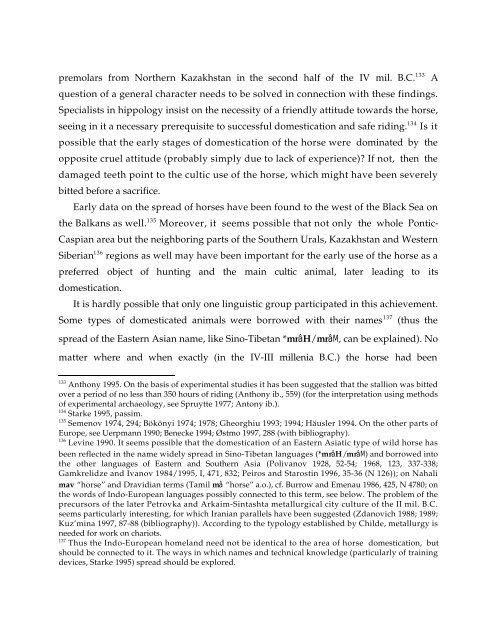Comparative Notes on Hurro-Urartian, Northern Caucasian
Comparative Notes on Hurro-Urartian, Northern Caucasian
Comparative Notes on Hurro-Urartian, Northern Caucasian
Create successful ePaper yourself
Turn your PDF publications into a flip-book with our unique Google optimized e-Paper software.
premolars from <strong>Northern</strong> Kazakhstan in the sec<strong>on</strong>d half of the IV mil. B.C. 133 A<br />
questi<strong>on</strong> of a general character needs to be solved in c<strong>on</strong>necti<strong>on</strong> with these findings.<br />
Specialists in hippology insist <strong>on</strong> the necessity of a friendly attitude towards the horse,<br />
seeing in it a necessary prerequisite to successful domesticati<strong>on</strong> and safe riding. 134 Is it<br />
possible that the early stages of domesticati<strong>on</strong> of the horse were dominated by the<br />
opposite cruel attitude (probably simply due to lack of experience)? If not, then the<br />
damaged teeth point to the cultic use of the horse, which might have been severely<br />
bitted before a sacrifice.<br />
Early data <strong>on</strong> the spread of horses have been found to the west of the Black Sea <strong>on</strong><br />
the Balkans as well. 135 Moreover, it seems possible that not <strong>on</strong>ly the whole P<strong>on</strong>tic-<br />
Caspian area but the neighboring parts of the Southern Urals, Kazakhstan and Western<br />
Siberian 136 regi<strong>on</strong>s as well may have been important for the early use of the horse as a<br />
preferred object of hunting and the main cultic animal, later leading to its<br />
domesticati<strong>on</strong>.<br />
It is hardly possible that <strong>on</strong>ly <strong>on</strong>e linguistic group participated in this achievement.<br />
Some types of domesticated animals were borrowed with their names 137 (thus the<br />
spread of the Eastern Asian name, like Sino-Tibetan *mrâH/mrâM, can be explained). No<br />
matter where and when exactly (in the IV-III millenia B.C.) the horse had been<br />
133 Anth<strong>on</strong>y 1995. On the basis of experimental studies it has been suggested that the stalli<strong>on</strong> was bitted<br />
over a period of no less than 350 hours of riding (Anth<strong>on</strong>y ib., 559) (for the interpretati<strong>on</strong> using methods<br />
of experimental archaeology, see Spruytte 1977; Ant<strong>on</strong>y ib.).<br />
134 Starke 1995, passim.<br />
135 Semenov 1974, 294; Bökönyi 1974; 1978; Gheorghiu 1993; 1994; Häusler 1994. On the other parts of<br />
Europe, see Uerpmann 1990; Benecke 1994; Østmo 1997, 288 (with bibliography).<br />
136 Levine 1990. It seems possible that the domesticati<strong>on</strong> of an Eastern Asiatic type of wild horse has<br />
been reflected in the name widely spread in Sino-Tibetan languages (*mrâH/mrâM) and borrowed into<br />
the other languages of Eastern and Southern Asia (Polivanov 1928, 52-54; 1968, 123, 337-338;<br />
Gamkrelidze and Ivanov 1984/1995, I, 471, 832; Peiros and Starostin 1996, 35-36 (N 126)); <strong>on</strong> Nahali<br />
mav “horse” and Dravidian terms (Tamil mâ “horse” a.o.), cf. Burrow and Emenau 1986, 425, N 4780; <strong>on</strong><br />
the words of Indo-European languages possibly c<strong>on</strong>nected to this term, see below. The problem of the<br />
precursors of the later Petrovka and Arkaim-Sintashta metallurgical city culture of the II mil. B.C.<br />
seems particularly interesting, for which Iranian parallels have been suggested (Zdanovich 1988; 1989;<br />
Kuz’mina 1997, 87-88 (bibliography)). According to the typology established by Childe, metallurgy is<br />
needed for work <strong>on</strong> chariots.<br />
137 Thus the Indo-European homeland need not be identical to the area of horse domesticati<strong>on</strong>, but<br />
should be c<strong>on</strong>nected to it. The ways in which names and technical knowledge (particularly of training<br />
devices, Starke 1995) spread should be explored.





